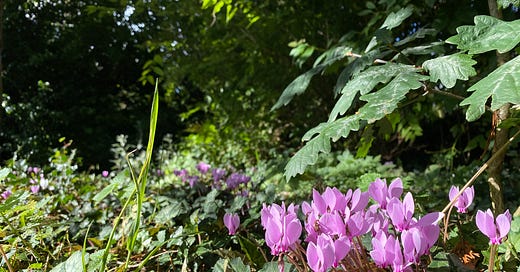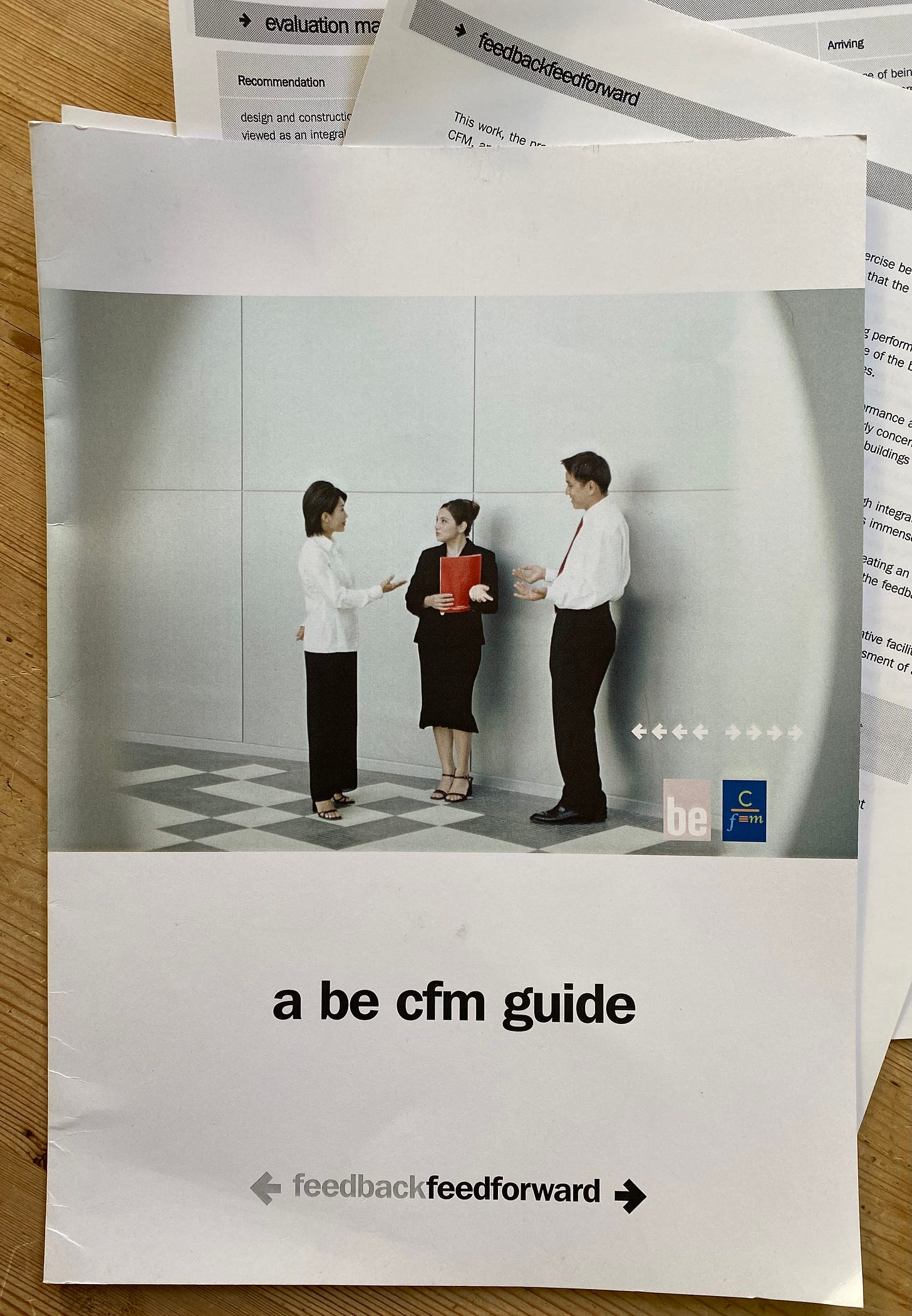Welcome to Regen/Notes, a round-up of regenerative notes joining dots and spaces. Thank you for subscribing, if you are not a subscriber as yet, then please do consider doing so to receive new posts and support Regen/Notes.
I recently rediscovered the article below, written early in 2004 for a piece of work done with Be Excellent (BE - now Constructing Excellence) linking collaboration across Facilities Management and Construction, under the title of FeedbackFeedforward. The notion being construction can feedforward to FM and FM feedback to construction on a win-win basis.
The construction industry zeitgeist at the time was still defined by the Egan Report, of achieving better value through collaborative working. The FeedbackFeedforward work was under the banner of aBECFM guide, a collaboration between BE and the Centre for Facilities Management. The focus of the article below explored how a collaborative approach would benefit the environment.
I am sharing here as I now realise many of the topics covered in this article were maybe forward-thinking for that time. At a time I was transitioning from business improvement director to self-employed built improvement consultant. Looking back, I am fascinated to see how my thinking then was the seed for where I am today, for the journey from environmental management to sustainable to restorative to regenerative approaches.
And this was a few years before the Living Building Challenge came into being, and some 6 years before the LBC gave better structure to my approaches, and what we would now recognise as something closer to regenerative thinking for buildings.
The text is the as is print text from 2004, although I am struggling to find the published online FeedbackFeedforward version. I have added updates from here in 2022 at the end.
Collaborative sustainability, learning to think like a value tree.
As I write this, I am looking out of the study window at clear frosty dawn breaking in the east, with a full moon setting northwest over the Bowland Fells, nature appears fine and in order, yet this week's papers are full of the 2003 environmental broken records, evidence of the onset of global warming (whatever that means, whatever that will bring),
Every month seems to set a new extreme climatological record, thousands of heat-related deaths in France, the river Poe dries up, forest fires rage, glaciers retreat, the ski industry is in ruins, and no snow at Lapland Father Christmas.
Within the construction/facilities management arena, there is a current swell of focus on sustainability moving on from just environmental management. 2003 for me has largely been taken up with successful iso 14001 environmental management accreditations. Therefore the impact of our industries on the environment and sustainable development have been foremost in my mind.
There are a good number of approaches around at the moment with a sustainability tag: sustainable development, sustainable construction, sustainable FM etc. Yet, to be worthwhile and meaningful these need to contribute to the 1987 Bruntland definition of ‘doing nothing today that would compromise tomorrow's generation',
With the design, construction and FM we also need to fully embrace and integrate the three elements of sustainability, the triple bottom line, environmental social and financial - planet people and purpose - or ESF Environment, Social and Finance.
Whenever I facilitate workshops, present or talk on collaborative working, I always include messages around sustainability or collaborative sustainability. Yet too many think sustainability is not relevant to better ways of working together yet it is essential if we are to progress in sustainability, we cannot and will not do it working within silos, hence 'collaborative sustainability'.
Facilities management should drive the pan-industry collaborative approach to sustainable development, addressing the opportunities and responsibilities and influencing real progress. ABCFM Feedbackfeedforward Guide.
Grey to Green
Our attitude to the environment and sustainability could be viewed as a spectrum that ranged from grey to deep green, from business as usual to something that restores damage we have done. At the grey end or opportunist who will always see the environment there to be exploited, to be used to further our needs. At the deep green end are those who feel we are part of the environment, that we live in harmony within it and that we are intrinsically linked.
The most prominent of deep green thinking is the Gaia movement. And this is from this deep green thinking we have expressions such as think like a tree or to think like a mountain from John Muir, Aldo Leopold and others. Those in this colour of the spectrum feel that sustainable development will only be achieved by radical thinking.
And of course, in between these extremes, we have all the shades of grey to green, with the design construction and FM lodged in the grey zone.
The grey zone represents those who believe we can fix the environment with technology and progress towards sustainable development without changing our lifestyles, industry or patterns of thought.
Illustrative of this is our CO2 management and the strange concept of CO2 credits and CO2 trading, and perhaps paradoxically the explosion of windmills across our hills. Even the thousands planned would not contribute enough energy to replace that wasted in unnecessary nighttime lighting in office buildings across the country.
We approach problems, seeking solutions, from the wrong end because it is easier to do, thinking we can manage our way out of global warming, rather than think and act radically different.
The significant problems we face cannot be solved at the same level of thinking we were when we created them. (Einstein)
As professionals, organisations and individuals we need to be aware of where we are on the grey to green spectrum This is important if as projected the global need for the built environment will be 2.8 planets worth of resources within the next 30 years if we carry on as we are.
We should ask ourselves, why, within our (design, build, FM) professions:
- So few built environment organisations have environmental statements within their core values,
- So few organisations report on CSR,
- Only one built environment organisation globally has committed to the 1% for the Planet movement. (Paying for our use of our planet)
There are pockets of encouraging focus on sustainability matters at present. However, the patterns of thought that are dominant within our sector, those that created unsustainable practices and buildings will not provide the tipping point to fix the problems we face.
There may still be a lack of recognising and understanding of the need to change. To fully move into a sustainable future, new patterns of thought will be required, these are emerging but not fast enough. Where we see sustainability patterns of thought emerging are through collaboration with organisations once considered cranky, too political and troublesome (Friends of the Earth, CAT, Greenpeace etc) who are now providing corporate education awareness and consultation services.
We are made wise, not by the recollection of the past, but by responsibility for the future. George Bernard Shaw
There are several approaches and practices currently gaining recognition that will undoubtedly speed our progress toward sustainable development and these fit very closely within the principles of collaborative working, and indeed with the ABeCFM Feedbackfeedforward working group explorations and this publication.
Delivering Superior Value (including superior sustainability delivery) through;
Understanding customer values,
Supply Chain Management,
Integrated Processes,
Managing Costs Collaboratively,
Continuous Improvement,
Leadership and People Development.
Collaborative Sustainability is out built environment working collaboratively with ecologists and environmentalists and in doing so addressing the real environmental, social and financial win-wins.
Value Management and Engineering when embracing sustainability can help arrive at a sustainable approach for projects that;
delivers real positive good, not just reduced bad,
is fit for the planet, fit for people and fit for purpose,
reaches collaboration on project team values.
And on the technique of developing value management ‘trees’, maybe we should see value trees planted and grow as the project develops.
Imagination is more important than knowledge. (Einstein again)
As the farming and agriculture sector is now recognising the value of restorative environmental practices through schemes financially rewarding stewardship. Maybe we need to adapt the same practice for use in our built environment. There are schemes, for example, the Fusion 21 project which uses savings, derived from collaborative working and waste reduction to support local social school and charity needs. Maybe we should extend this thinking to built environment sustainability and CO2 management?
In summary, the key to really addressing our poor sustainable approaches and practices is with people's development and education. Many of our tools, techniques and measuring models focus only on the hard, technical side of sustainability.
We need a real focus on behaviour and attitudes toward sustainability and our planet How many industry leaders and individuals have job descriptions and competencies linked to sustainable or environmental matters, as they have for health and safety?
For real progress in sustainability it comes down to who we are and what we bring to projects, not just through following checklists and guidelines, working to certification schemes when requested, yet making the decision not to do so when not required by clients or legislation.
Inspirations (were listed as):
John Muir
Eco-Self
Paul Hawken, Ecology of Commerce
Jim Ure and David Hampton (then at ABS Consulting) Delivering Sustainable Facilities Management (SFM) a process that optimises financial, environmental and social factors in support of the primary purpose of the organisation
Common Sense
Comments from here in 2022:
Themes from this article …
- were reflected in the CFM paper with Keith Alexander in 2006. Community-Based Facilities Management.
- developed into a Be2Camp Sustainability Manifesto in 2009, as an alignment with the emerging social media and Web2.0
- were further developed and represented in FutuREstorative in 2016, of note being the grey to green spectrum, from deep ecology, and embracing sustainability within restorative value management and engineering exercises, asking the question: what if every value engineering exercise could make the world a better place?




